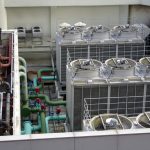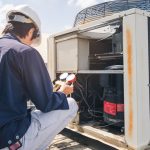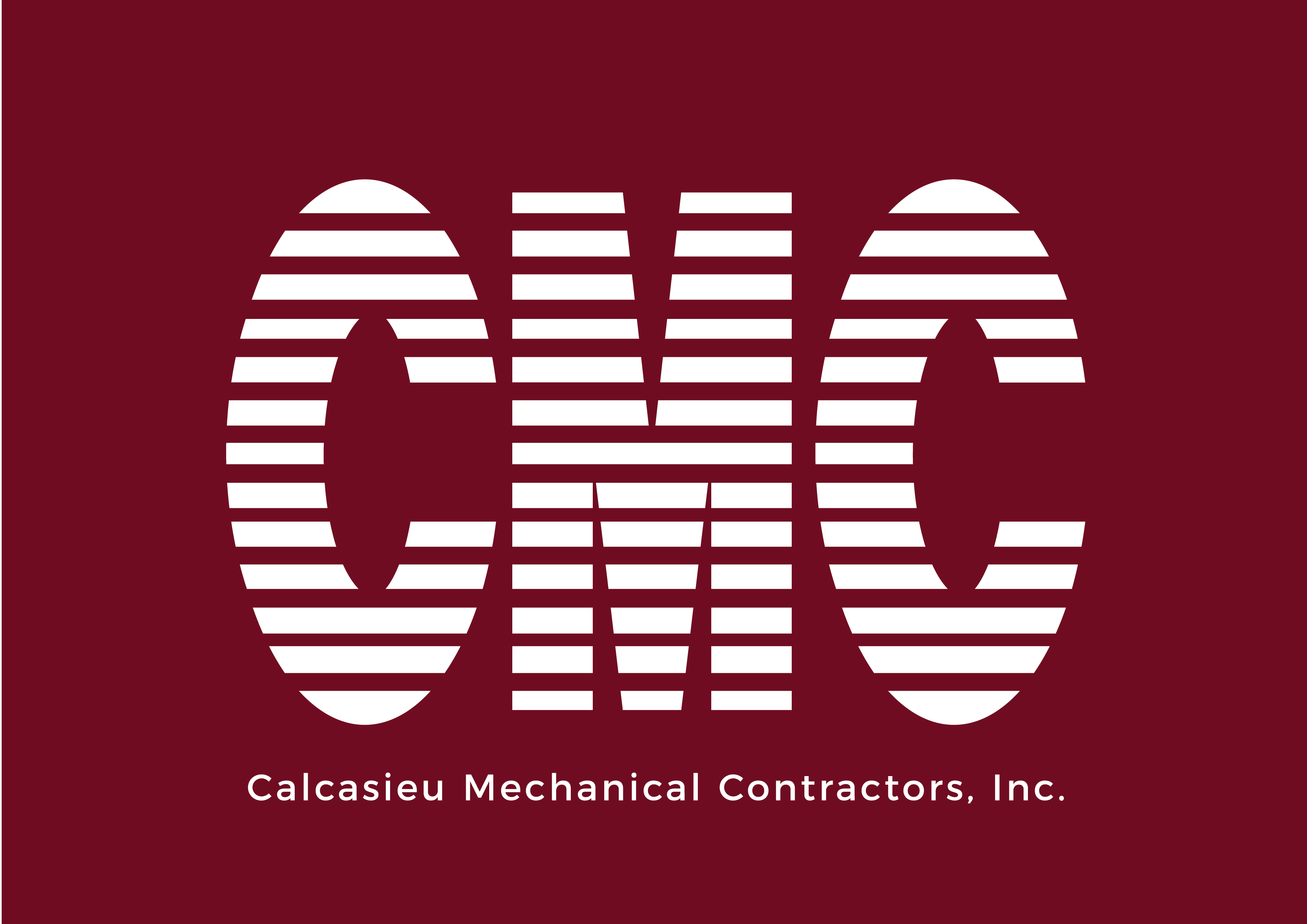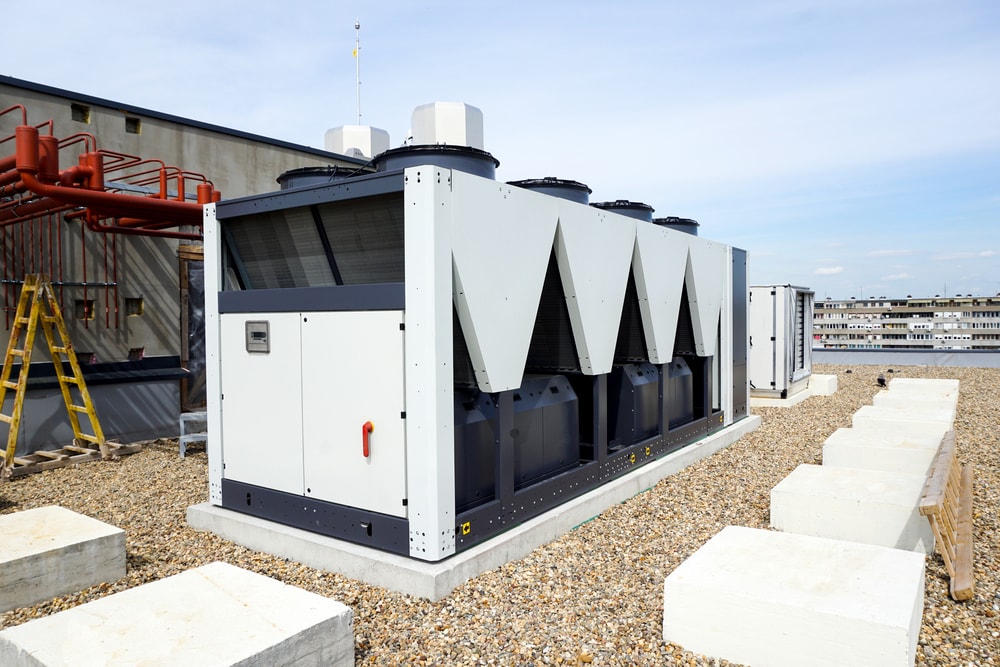
How Long Commercial HVAC Systems Last?
December 8, 2023
Maximize Comfort: Your Guide to Commercial HVAC Solutions
February 8, 2024Picture a sweltering summer day, the kind that makes you praise the invention of air conditioning. That’s when chillers are the unsung heroes in HVAC systems. They’re like bouncers at a club, keeping the unwanted heat out and making sure everything stays cool inside.
I’ve wrestled with these machines up close—crawling through their metallic guts to troubleshoot an issue or optimize performance can feel like solving a complex puzzle where every piece impacts another.
You’ll learn how these devices pull off their magic trick: turning hot into cold using some pretty nifty science. We’ll explore each part—the evaporator, compressor, condenser, expansion valve—and show you how they work together in perfect harmony. And because nobody likes wasting cash or hurting Mother Earth, we’ll also touch on making your chiller run efficiently.
Table Of Contents:
- Understanding the Basics of HVAC Chillers
- The Core Components of a Chiller System
- The Refrigeration Cycle Explained
- Types of Chillers and Their Applications
- Energy Efficiency in Chiller Operations
- Installation Considerations for Chiller Systems
- Troubleshooting Common Chiller Problems
- Advancements in Chiller Technology
- FAQs in Relation to How Does a Chiller Work Hvac
Understanding the Basics of HVAC Chillers
Imagine a superhero that can suck heat out of water and spit out chilled air like it’s nobody’s business. That’s your chiller, working tirelessly behind the scenes in large buildings to keep everyone cool and comfy.
A chiller is a giant refrigerator that uses either an absorption cycle or vapor compression to do its magic. It circulates a refrigerant through a closed system where it picks up heat from the building interior and then ejects that unwanted warmth outside, leaving nothing but cold comfort behind.
The Core Components of a Chiller System
An HVAC chiller has four main squad members: an evaporator, compressor, condenser, and expansion valve. First off, we have the evaporator, which takes in warm liquid (usually water) from the building space needing cooling. This part acts as the chill-out zone for this hot liquid as it transfers its thermal energy over to cooler refrigerant inside.
Moving on to the compressor, which lives up to its name by compressing low-pressure refrigerant gas into high-pressure hot stuff – think steamy summer sidewalk versus chilly mountain breeze levels of pressure change here. Then comes the condenser, essentially playing the opposite day with our now-warm refrigerant; instead of soaking up the heat, it dumps all that excess baggage outdoors via fans or cooling towers.
Last but not least is the expansion valve. This nifty little gatekeeper regulates how much-compressed refrigerant makes its way back into the evaporator – because too much would be like trying to fit an elephant onto one of those kiddie rides at an amusement park – just doesn’t work.
All these parts play together like an orchestra creating beautiful symphonies—only instead of music they’re pumping out blissful cold air for us mortals sweating away down below.
Think of chillers as the superheroes of cooling, sucking out heat and blasting cold air. They’re giant fridges using high-tech cycles to keep buildings cool.
The Core Components of a Chiller System
Imagine your chiller as the heart of your building’s HVAC system, pumping chilled water to keep the indoor climate cool and comfortable. But what makes up this vital piece of machinery? Well, it’s all about four main parts: the evaporator, compressor, condenser, and expansion valve.
The Evaporator: Where Chill Begins
In any good thriller movie, there’s always that chilling moment where everything kicks off – in our chiller saga, that’s the role of the evaporator. This is where we start with warm liquid entering into its chambers. Here’s how it goes down – heat from the liquid gets absorbed by refrigerant which causes said refrigerant to boil (spooky stuff), turning from a low-pressure liquid into vapor. This process pulls heat out like no one’s business leaving behind nothing but coldness.
This part might sound simple but don’t be fooled; proper maintenance here can mean fewer repairs down the line because who doesn’t love avoiding unnecessary drama?
The Compressor: Powering Up The Cool
If you’ve ever felt under pressure then you’ve got something in common with the compressor, which squeezes or compresses refrigerant vapor like an intense workout session for gases. It raises both temperature and pressure making sure everything stays moving – think energy drinks for chillers if they had gym memberships.
The Condenser: Heat Wave Goodbye.
Here comes my favorite part—the condenser. You could say this component likes things hot since it takes all that high-temperature vapor from our hardworking compressor friend and cools it right back down until it becomes a high-pressure liquid again. Think about taking a hot shower and then stepping out into fresh air —that sudden cooling sensation is pretty much what happens inside this powerhouse section of our chiller buddy.
The Expansion Valve: Keeping It Cool Under Pressure
Last but not least we have the expansion valve. Now imagine controlling traffic at rush hour without causing chaos—that’s kind of what these guys do with refrigerant flow. They throttle back on high-pressure liquids making them drop their pressure before heading back into evaporation land ready to absorb more heat so we can keep looping around staying cool forever…or at least throughout those scorching summer months.
Chillers are like the cool guardians of our buildings, and they’ve got four musketeers doing all the heavy lifting: evaporators get things cold, compressors pump up the energy, condensers wave off the heat, and expansion valves keep everything flowing just right.
The Refrigeration Cycle Explained
Think of a chiller as a bouncer at the club of temperature control, keeping the heat out so everyone inside stays cool. At its heart lies the refrigeration cycle, which is like doing the cha-cha: fluid moves in a loop and with each step, it changes state to keep things chill.
Step One: Evaporation
In this phase, our liquid refrigerant hits the dance floor—the evaporator—and absorbs heat from the surrounding water or glycol solution. This process transforms it into vapor. Just picture your iced coffee on a hot day; as it sweats in the sun, that’s our hero picking up thermal energy and getting ready for its next move.
Step Two: Compression
The party heats up when our now-vaporized refrigerant struts over to the compressor. Here we crank up pressure faster than an espresso machine on Monday morning—this amps up temperature because high-energy particles are squeezed tighter together.
Step Three: Condensation
Moving along to where things cool down again—the condenser—it’s time for some reverse magic. The vapor gives away all that heat it danced away with earlier through coils or towers. It goes from gaseous backbeat boogieing straight into smooth solid-like moves—a chilled-out liquid once more.
Step Four: Expansion Valve Therapy
This little device acts like therapy for pressurized liquids needing relief after too much dancing—or should I say compressing? Dropping pressure without spilling any tea (or refrigerant), sets us right back where we started but cooler than ever before. Energy efficiency buffs know what I’m talking about, since here’s where precise control keeps operational costs low while being kinder to Mother Earth. And there you have it folks—that’s how Calcasieu Mechanical Contractors gets down with chilling.
Think of chillers as club bouncers for temperature, with a refrigeration cycle that’s like a dance keeping things cool. They absorb heat and transform states through evaporation, get energized by compression, release heat during condensation, and hit the reset button at the expansion valve to start fresh.
Types of Chillers and Their Applications
Chillers are like the unsung heroes of HVAC, keeping things cool under pressure. They come in different flavors—each with its special twist for chilling out your space.
Air-Cooled Chillers: The Cool Breeze Cousins
Air-cooled chillers are the laid-back type; they use fans to blow away heat, making them great for areas where water is as scarce as a snowman in the desert. Picture these guys on top of buildings or in open spaces where they can breathe easily and do their thing without using too much H2O.
The best part? These units tend to have lower installation costs since you’re not dealing with complex cooling towers. But remember, while air-cooled chillers love basking in open-air freedom, they might get thirsty more often—meaning higher operational costs because electricity isn’t cheap.
Water-Cooled Chillers: The Deep Divers
If air-cooled chillers are kicking back poolside, then water-cooled chillers are diving deep into the ocean’s abyss. They link up with cooling towers and a source of water to shuttle away heat like it’s a hot potato—or should we say hot liquid?
Sure, installing these aquatic acrobats takes more upfront cash because you’ll need that extra gear—a tower that thinks it’s part rainmaker—but their operating expenses often end up lower than their air-loving cousin’s thanks to better efficiency stats when it comes down to brass tacks.
Absorption Chillers: The Sorcerors Stirring the Potions
Last but not least meet absorption chillers—the magicians who don’t even need electricity. Instead of compressors powered by volts and amps, these alchemists use thermal energy. This could be waste heat from industrial processes or even solar power if you want eco-friendly vibes.
Ideal for facilities swimming in excess heat or those going green faster than a chameleon on St. Patrick’s Day, absorption chillers offer an ingenious way to turn what would be wasted into something wickedly cool.
Chillers are HVAC’s secret weapon for staying cool, each with its unique setup. Air-cooled chillers are easy to install but can be costly to run, while water-cooled versions dive deep for efficient cooling and lower ongoing costs. And don’t forget absorption chillers—they work like magic using heat instead of electricity.
Energy Efficiency in Chiller Operations
Chillers are the quiet workhorses of large commercial HVAC systems, humming away in basements and on rooftops. They’re also notorious energy hogs, but that’s changing faster than a popsicle melts in July. Here’s how savvy businesses can turn their chillers into models of efficiency.
The Lowdown on High Performance
Cutting down your chiller’s appetite for power starts with understanding its innards—compressors, condensers, evaporators—you name it. Like tuning a grand piano or tweaking a race car, optimizing each component plays a crucial part in hitting those high-efficiency notes.
But let’s get real: it’s not just about fine-tuning what you’ve got; sometimes an upgrade is overdue. Swapping out that old compressor for something more modern might sting the wallet at first glance—but think long-term gains over short-term pains.
A Balancing Act Worth Mastering
Balancing load demands isn’t some circus trick—it’s serious business when it comes to chillers. It means running them at peak performance without making them break a sweat (or freeze). Variable frequency drives are like dimmer switches for your lights—they let you dial back energy use without shutting down operations entirely.
To master this balancing act, regular maintenance is key. Clean tubes mean happy chillers—and happier utility bills too.
Tech That Pays Off Big Time
We live in exciting times where tech upgrades give us more control over our environment while pocketing some savings too. Smart controls take data-driven decisions to new heights by constantly adjusting settings based on actual needs—not just educated guesses or fixed schedules.
Dive into how smart tech slashes consumption, and you’ll see why there’s a buzz around these innovations that seem straight out of science fiction (but are available today).
Chillers can be energy-efficient powerhouses with the right tweaks and tech. Think of fine-tuning components like a grand piano, consider smart upgrades for long-term savings, balance your load demands carefully, and remember—regular maintenance keeps those utility bills low. Embrace modern controls to make data-driven decisions that cut costs without cutting corners. It’s not just about saving money; it’s about being smart with the energy we use.
Installation Considerations for Chiller Systems
When you’re setting up a new chiller system, it’s like planning a dinner party in your tiny apartment kitchen. You’ve got to know how much space you have and what you can fit into that space without causing chaos when the guests arrive.
Sizing Up Your Space
The size of your chiller should match the heat load requirements with some room for growth because nobody likes being stuck in tight pants after Thanksgiving dinner. This isn’t just about physical dimensions; capacity plays a huge role too. Getting this right means fewer headaches down the line.
If we’re talking big commercial chillers, think about future expansions or changes in building use. It’s better to scale up now than retrofit later.
Picking the Perfect Spot
You wouldn’t put your fridge next to the oven, so don’t install chillers where they’ll struggle either. Airflow is king here – if it’s blocked or restricted, efficiency drops faster than cell service in an elevator.
Consider access for maintenance too because nothing is worse than trying to fix something that’s as reachable as last year’s holiday decorations on top of your cabinets.
Maintenance Access Is Non-Negotiable
Think about long-term relationships – not all are easy but having clear paths helps avoid bumpy roads. Ensure there’s enough room around equipment for regular check-ups and repairs which will keep performance smoother and longer—like using high-quality oil keeps engines purring over time.
Designing with maintenance mindsets saves money and prevents downtime drama later on.
Remember: picking out a chiller isn’t like grabbing milk at the store; these considerations ensure you’re investing wisely—and not just throwing cash into another appliance that’ll give out during summer’s first heatwave.
Plan your chiller setup like a pro: Match the size to your heat load needs with extra space for future growth, install it in a spot with good airflow, and make sure there’s easy access for maintenance. This will save you money and prevent headaches later.
Troubleshooting Common Chiller Problems
When your chiller starts acting up, it’s like a bad actor on stage—everyone notices. But don’t sweat; we’re here to help you get back in the director’s chair and fix those common issues.
Noisy Operations: The Soundtrack of Chiller Woes
If your chiller is louder than a rock concert, there could be air or non-condensable gases trapped inside, making the compressor work overtime. Think of it as trying to jog with a backpack full of rocks—it’s not going to end well for anyone involved. A good old-fashioned purge might just do the trick.
Another culprit behind this cacophony could be loose components vibrating against each other—a symphony you didn’t sign up for. Tighten them up before they dance themselves into disrepair.
Inconsistent Cooling: When Chillers Get Moody
Just like people, chillers can have mood swings—in temperature form. If yours is cooling like an indecisive weather pattern, check out the thermostat settings first—they should be as steady as a metronome’s beat.
Sometimes though, scale buildup acts much like cholesterol in arteries by blocking flow and efficiency; regular cleaning will keep that thermal transfer smooth and even-tempered.
Leaks: Playing Detective with Your System
Finding leaks in your system feels like playing hide-and-seek with something that doesn’t want to be found—but find it you must. Start by checking all fittings and connections; they can loosen over time faster than social media trends change.
- Gaskets are often leak culprits too because let’s face it—they’re under constant pressure (literally).
- Piping insulation also needs scrutiny since degradation here invites moisture problems—and nobody invited them.
Remember that keeping cool isn’t always easy but addressing these common chiller issues head-on means less downtime drama and more reliable performance curtain calls.
Got chiller drama? Loud noises might mean trapped air or loose parts—purge or tighten up. Moody cooling? Check your thermostat and clean out any scale buildup. Leaks playing hide-and-seek? Inspect fittings, gaskets, and insulation to keep moisture out.
Advancements in Chiller Technology
Chillers have long been the backbone of large-scale cooling, but recent tech leaps are turning them into brainy, energy-sipping giants. With new designs and smarter controls, these systems aren’t just chilling; they’re revolutionizing how we keep it cool.
Innovative Compressor Design
Magnetic bearing compressors are shaking things up. By ditching traditional oil-lubricated bearings for magnets, these chillers cut down on friction and wear—think ice skating without the risk of falling over. This means less maintenance and a performance so smooth it’d make jazz musicians jealous.
The secret sauce? Magnetic levitation technology that makes compressor parts float like a magic carpet ride you can control with your fingertips—almost literally. And let’s not forget: fewer moving parts mean whisper-quiet operation because nobody likes a noisy neighbor.
Smart Diagnostics Get Smarter
We’ve entered an era where chillers self-diagnose faster than you can Google your symptoms after a sneeze. Modern chiller systems come equipped with advanced analytics capable of predicting issues before they happen—it’s like having a crystal ball for HVAC health.
This isn’t just guesswork; sophisticated algorithms analyze patterns to warn about potential breakdowns way ahead of time, letting technicians take preemptive action that would impress even the most proactive planner out there.
Coolants That Care About The Planet
Gone are the days when refrigerants were notorious ozone-depleting villains—the latest batch has turned over a new leaf entirely. Eco-friendly alternatives are making waves by minimizing environmental impact while delivering top-notch cooling power.
- New non-ozone depleting substances (NODS) slash global warming potential (GWP) numbers down drastically,
- Liquid-based solutions play nice with both Mother Nature and stringent regulations,
- HFO blends are making waves, taking sustainability to new heights we’ve never seen before.
Chillers are getting a brainy upgrade with magnetic bearing compressors for smoother, quieter operation and smart diagnostics that predict problems before they arise. Plus, new coolants show we can keep it cool without harming the planet.
FAQs in Relation to How Does a Chiller Work Hvac
What are the 4 stages of a chiller?
A chiller operates through evaporation, compression, condensation, and expansion to cool fluid for heat transfer.
How does chiller principle work?
The chiller absorbs heat from process water and then moves it into the air around the system.
How does an air chiller work?
An air chiller uses fans to disperse heat absorbed by refrigerant vapor via an external coil.
What is a chiller vs HVAC?
A chillers focus on cooling fluids. HVAC systems manage overall indoor climate including heating, ventilation and cooling.
So, you’ve journeyed through the ins and outs of chillers. You now know how a chiller works HVAC style; it’s that essential gear in your climate control arsenal. They kick out heat with finesse, thanks to the refrigeration cycle.
Dive into their world, and you’ll meet the core team: evaporators get cozy with coolants, compressors pump up pressure, condensers show heat the door, and expansion valves keep everything flowing just right.
Remember this—efficiency isn’t just nice to have; it’s a must for both your wallet and our planet. Installation? It’s all about location and sizing things up correctly.
Troubles may come knocking but stay sharp—common problems are often easy fixes when you’re clued in.
The last thing – technology marches on. Keep an eye out because today’s whiz-bang feature is tomorrow’s standard issue!

Hailing from the picturesque town of Lake Charles, Louisiana, Jim Blanchard stands as an exemplar in commercial HVAC installation and services. As President of Calcasieu Mechanical, he has leveraged his deep industry knowledge and innovative strategies to establish the company as a leading regional service provider. Under Jim’s leadership, Calcasieu Mechanical has expanded its portfolio of high-quality services and earned the trust and respect of businesses throughout Louisiana. The company’s commitment to excellence, reflected in its endeavors, stems from Jim’s dedication to ensuring every project meets and exceeds client expectations.

